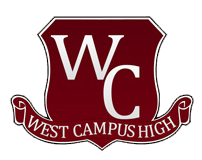Engineering Department
Engineering Department
Welcome to the West Campus Engineering Department! Follow us on Instagram @westcampusengineering. The emphasis is to get the students to be problem solvers using teamwork, a problem-solving process, and creativity.
Change brings new possibilities. The focus for this year will be “Engineers Impacting the Community” and “Design as a Process”.
Mr. Spycher teaches the 3rd year of engineering. The campus is actively looking for another engineering and computer programming teacher. Please share and encourage anyone interested in the position to apply here
CREATE, Rocketry, Robotics, and GirlsWhoCode.
At this time, these after school programs are needing a club
advisor and leader. If you can help with these
programs, please reach out to Mr.
McMeekin. You don’t have to be in the engineering classes to
participate. We need leaders to make these programs a
success. Leadership is one of those qualities that scholarships
and college applications are looking for. Plus, there’s nothing
more rewarding than being part of a successful program.
Parents - We need mentors and experts
for Rocketry, Robotics, and Programming. Parents and other
Business professionals are highly encouraged to participate in
these programs as mentors and trainers. We also need volunteers
to help with everything from chaperoning, planning,
and helping with acquiring materials and supplies.
Engineering Classes:
- Year 1 – Introduction to Engineering Design (IED)
- Year 2 – Principles of Engineering - (POE)
- Year 3 – Civil Engineering & Architecture (CEA)
- Year 4 – Engineering Design & Development (EDD)
We have three additional clubs/afterschool programs for the engineering students.
- CREATE program. This is a student led team. All engineering students are invited to participate.
- Rocketry program. Link to learn more
- Girls Who Code. Link to learn more
Year 1 – Introduction to Engineering Design
(IED)
First-year engineering students learn the process of
engineering and applying that process with others. They
learn how to create ideas, design, test, revise, innovate,
understand underlying principals and properties, work together,
and present their projects. These are not worksheets; they are
designed for students to develop their own areas of skills and
knowledge.
- Engineering Units: 3D design, software engineering, architecture, graphics, reverse engineering, sketching, brainstorming, presenting, competitions, communication, problem solving, final project.
- End-of-year project: Students prepare all year for this. They solve a problem that challenges them to use and enhance skills and knowledge from their previous projects. They will present these projects to all students during Engineering Day at the end of May.
- Value: Students learn the value of the skills and knowledge in each of their projects.
Examples of work for first year students can be found in the side panel.
Year 2 – Principles of Engineering (POE)
Second-year engineering students take a more hands-on approach to
learning. Projects are designed by the students so they can learn
specific skills and knowledge.
- Through problems that engage and challenge, students explore a broad range of engineering topics, including mechanisms, the strength of structures and materials, and automation. Students develop skills in problem solving, research, and design while learning strategies for design process documentation, collaboration, and presentation.
- End-of-year project: Students design a project that solves a problem that challenges them to use and enhance skills and knowledge from their previous projects. They present these projects to all students during Engineering Day at the end of May.
- Value: Students learn the value of the skills and knowledge in each of their projects.
- Each student acquires at least one John-McMeekin@scusd.eduMentor to advise and assist them in gaining insight and knowledge about their area of interest. They are also required to find outside experts for their end-of-year project.
Year 3 – Civil Engineering &
Architecture (CEA)
Students learn important aspects of building and site design and
development. They apply math, science, and standard engineering
practices to design both residential and commercial projects and
document their work using 3-D architectural design software.
Year 4 – Engineering Design & Development
(EDD)
The knowledge and skills students acquire throughout PLTW
Engineering come together in Engineering Design & Development as
they identify issues and then research, design, and test a
solution, ultimately presenting their solution to a panel of
parents and outside experts. Students apply the professional
skills they have developed to document a design process to
standards, completing Engineering Design & Development ready to
take on any post-secondary program or career.
For more information contact: John McMeekin
